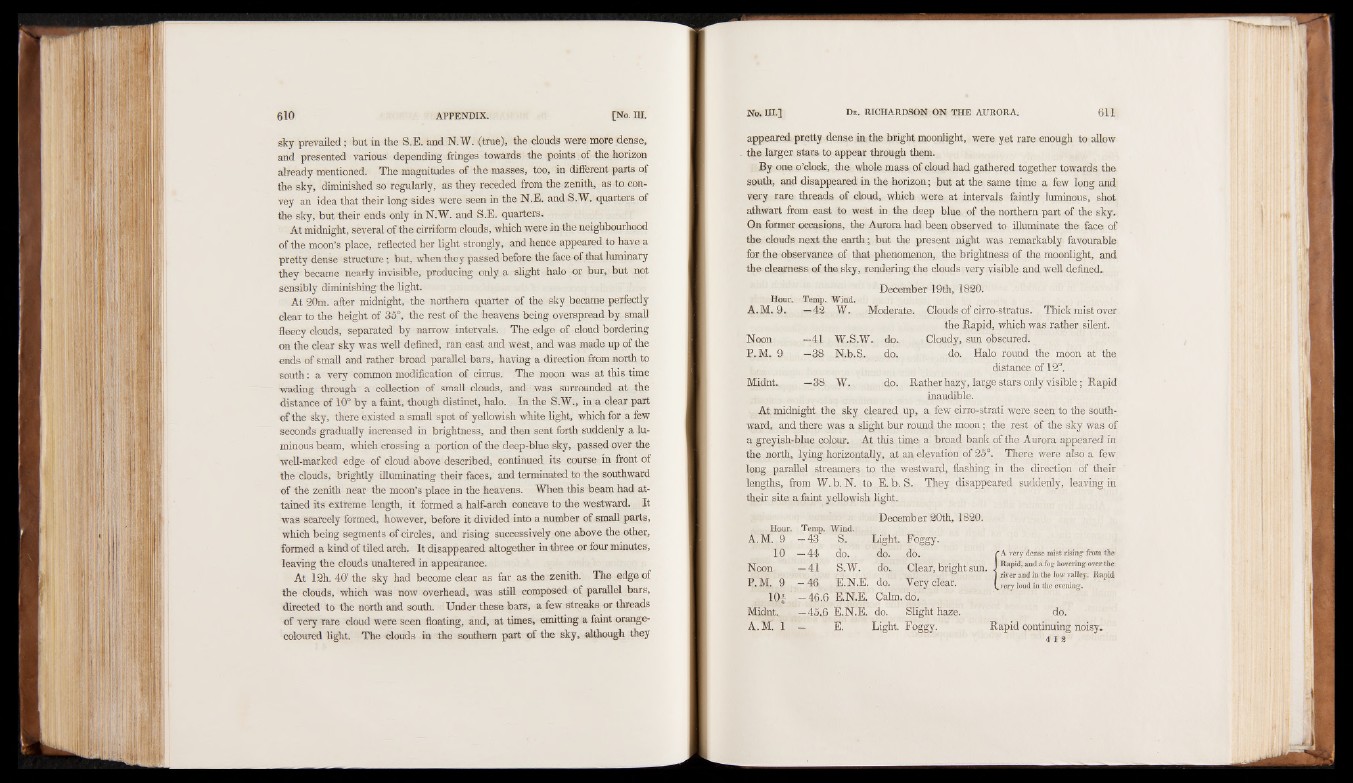
sky prevailed; but in the S.E. and N.W. (true), the clouds were more dense,
and presented various depending fringes towards the points of the horizon
already mentioned. The magnitudes of the masses, too, in different parts of
the sky, diminished so regularly, as they receded from the zenith, as to convey
an idea that their long sides were seen in the N.E. and S.W. quarters of
the sky, but their ends only in N.W. and S.E. quarters.
At midnight, several of the cirriform clouds, which were in the neighbourhood
of the moon’s place, reflected her light strongly, and hence appeared to have a
pretty dense structure; but, when they passed before the face of that luminary
they became nearly invisible, producing only a slight halo or bur, but not
sensibly diminishing the light.
At 20m. after midnight, the northern quarter of the sky became perfectly
clear to the height of 35°, the rest of the heavens being overspread by small
fleecy clouds, separated by narrow intervals. The edge of cloud bordering
on the dear sky was well defined, ran east and west, and was made up of the
ends of small and rather broad parallel bars, having a direction from north to
south: a very common modification of cirrus. The moon was at this time
wading through a collection of small douds, and was surrounded at the
distance of 10° by a faint, though distinct, halo. In the S.W., in a clear part
of the sky, there existed a small spot of yellowish white light, which for a few
seconds gradually increased in brightness, and then sent forth suddenly a luminous
beam, which crossing a portion of the deep-blue sky, passed over the
well-marked edge of cloud above described, continued its course in front of
the clouds, brightly illuminating their faces, and terminated to the southward
of the zenith near the moon’s place in the heavens. When this beam had attained
its extreme length, it formed a half-arch concave to the westward. It
was scarcely formed, however, before it divided into a number of small parts,
which being segments of circles, and rising successively one above the other,
formed a kind of tiled arch. It disappeared altogether in three or four minutes,
leaving the clouds unaltered in appearance.
At 12h. 40' the sky had become clear as far as the zenith. The edge of
the douds, which was now overhead, was still composed of parallel bars,
directed to the north and south. Under these bars, a few streaks or threads
of very Tare doud were seen floating, and, at times, emitting a faint orange-
coloured light. The douds in the southern part csf the sky, although they
appeared pretty dense in the bright moonlight, were yet rare enough to allow
the larger stars to appear through them.
By one o’clock, the whole mass of cloud had gathered together towards the
south, and disappeared in the horizon; but at the same time a few long and
very rare threads of doud, which were at intervals faintly luminous, shot
athwart from east to west in the deep blue, of the northern part of the sky.
On former occasions, the Aurora had been observed to illuminate the face of
the douds next the earth; but the present night was remarkably favourable
for the observance of that phenomenon, the brightness of the moonlight, and
the clearness of the sky, rendering the clouds very visible and well defined.
December 19th, 1820. Hour. Temp. Wind. A.M.9, -4 2 W. Moderate. Clouds of cirro-stratus. Thick mist over
the Rapid, which was rather silent.
Noon -41 W.S.W. do. Cloudy, sun obscured.
P.M. 9 —38 N.b.S. do. do. Halo round the moon at the
distance of 12".
Midnt, -3 8 . W. do. Rather hazy, large stars only visible; Rapid
inaudible.
At. midnight the sky cleared up, a few cirro-strati were seen to the southward,
and there was a slight bur round the moon; the rest of the sky was of
a greyish-blue colour. At this time a broad bank of the Aurora appeared in
the north, lying horizontally, at an elevation of 25°. There were also a few
long parallel streamers to the westward, flashing in the direction of their
lengths, from W. b. N. to E. b. S. They disappeared suddenly, leaving in
their site a faint yellowish light.
December 20th, 1820. A.MH. o9ur. Temp. Wind. - 4 3 ; S. Light. Foggy- 10 — 44 do. ' do. do.
Noon -4 1 S.W. do»* Clear, bright sun.
P.M. 9 -4 6 E.N.E. do. ' ;Very clear.
lOf j—46.6 E.N.E. Calm. do.
Midnt., -45.6 E.N.E. do. Slight haze.
a .m: 1 - Ë. Light. Foggy.
r A very dense mist rising- from the
J Rapid, and .a fog hovering over the
J river and in the low valley. Rapid
very loud in the evening.
do.
Rapid continuing noisy.
4 1 2